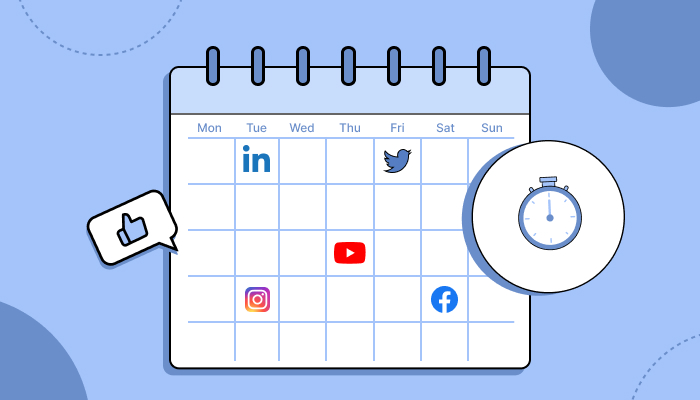In today’s digital landscape, consistency and strategic planning are crucial for effective social media marketing. A well-organized content calendar helps businesses maintain a steady flow of engaging content while maximizing their reach and engagement. In this blog, we’ll walk you through the essential steps to create a content calendar for your social media strategy.

Table of Contents
Toggle1. Define Your Goals
Before diving into content creation, establish clear goals for your social media presence. These goals will guide your content strategy and help you determine what to include in your calendar. Common objectives include:
- Increasing brand awareness
- Driving website traffic
- Generating leads or sales
- Boosting engagement and community interaction
- Promoting specific products or events
2. Identify Your Target Audience
Understanding your audience is key to creating relevant and engaging content. Research your audience’s demographics, interests, and behaviors. Consider the following:
- Age and gender
- Location
- Interests and hobbies
- Challenges and pain points
By knowing your audience, you can tailor your content to meet their needs and preferences.
3. Choose Your Social Media Platforms
Not every platform will be suitable for your business. Focus on the social media channels where your target audience is most active. Popular platforms include:
- Facebook: Great for community engagement and event promotion.
- Instagram: Ideal for visual content and brand storytelling.
- Twitter: Best for real-time updates and customer interaction.
- LinkedIn: Perfect for B2B marketing and professional networking.
- TikTok: Effective for reaching younger audiences with creative short videos.
4. Brainstorm Content Ideas
Now it’s time to generate ideas for your social media content. Consider a mix of content types to keep your audience engaged:
- Educational Content: Tips, how-tos, and industry insights.
- Promotional Posts: Information about sales, new products, or events.
- User-Generated Content: Showcase content created by your followers.
- Behind-the-Scenes Content: Give a glimpse into your company culture and processes.
- Engaging Content: Polls, quizzes, and interactive posts to encourage audience participation.
5. Select a Calendar Tool
Choose a tool that suits your workflow for managing your content calendar. Options include:
- Google Sheets/Excel: Simple and customizable for basic calendar needs.
- Trello: Visual project management tool that allows for easy collaboration.
- Asana: Great for teams, offering task management and timeline features.
- Hootsuite or Buffer: Social media management tools that offer built-in calendar features for scheduling posts.
6. Create a Template for Your Calendar
Design a content calendar template that includes essential columns or categories, such as:
- Date: The day you plan to post.
- Platform: The social media channel for each post.
- Content Type: Identify whether it’s an image, video, blog link, etc.
- Caption: Draft the post’s text or caption.
- Visuals: Note the images or videos you’ll use.
- Hashtags: List relevant hashtags for the post.
- Performance Metrics: Leave space for tracking engagement and performance after the post goes live.
7. Plan Your Posting Schedule
Determine how often you want to post on each platform. Consider your audience’s preferences and the best times to post for maximum engagement. General guidelines include:
- Facebook: 1-2 times per day
- Instagram: 1-3 times per day
- Twitter: 3-5 times per day
- LinkedIn: 1-2 times per week
- TikTok: 1-3 times per day
8. Schedule Your Content
Once your calendar is populated with content ideas, it’s time to schedule your posts. Use scheduling tools to automate posting, ensuring consistency and freeing up time for engagement and interaction.
- Hootsuite, Buffer, or Later: These tools allow you to schedule posts in advance across multiple platforms.
9. Monitor and Adjust Your Strategy
After implementing your content calendar, regularly monitor your social media performance. Analyze engagement metrics, such as likes, shares, comments, and click-through rates. This data will help you understand what resonates with your audience and allow you to make informed adjustments to your content strategy.
- A/B Testing: Experiment with different content types, posting times, and formats to see what works best.
10. Stay Flexible and Adaptable
While having a content calendar is essential for organization, it’s also important to remain flexible. Social media trends and audience preferences can change rapidly, so be prepared to adjust your calendar and content in response to real-time events or trending topics.
Conclusion
Creating a content calendar for social media is a strategic approach that can significantly enhance your marketing efforts. By defining your goals, understanding your audience, brainstorming diverse content ideas, and staying organized, you can effectively engage your followers and drive meaningful results. Remember to monitor performance regularly and be adaptable to changes in trends, ensuring your social media strategy remains relevant and impactful. Start planning today, and watch your social media presence thrive!


No responses yet